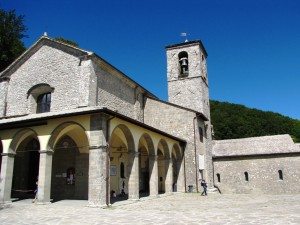
Immersed in the wooded Tuscan Apennines, on a rock spur overlooking a ravine, this sanctuary-convent is composed of a complex of buildings which has expanded over the centuries. These developments have not lessened the rough, wild look of the area, giving an idea of where and how Saint Francis would pray during certain periods of his life. In the Piazza del Quadrante, named for the sundial on the basilica, a wooden cross—beautiful in its simplicity—has been erected; from here, there is a lovely view of the surrounding mountains. Pass through the small square to reach the sanctuary’s main sites: the Basilica, the Corridor of the Stigmata, the Chapel of Santa Maria degli Angeli, the cloister, and the pilgrims’ quarters. Unfortunately, there isn’t space to discuss the numerous art works here, among them a series of masterpieces by Della Robbia, but simply list the principal sites in the sanctuary.
The Chapel of Santa Maria degli Angeli, the same size as the Porziuncola, is certainly the oldest building in the sanctuary. The area between the gate and the archway leading to the altar corrisponds to the chapel built between 1216 and 1218, as per Saint Francis’ request.
The Chapel of Magdalene was built at the beginning of the 15th century on the spot where the Saint’s first primitive wooden hut previously stood. The altar stone was once Francis’ table, on which, according to the Franciscan Sources, Jesus appeared.
After leaving the chapel, descend into the woods until reaching Sasso Spicco, one of the many fissures which almost resemble wounds in the stone of the mountain. Under an enormous boulder seemingly suspended in mid-air, a wooden cross marks the spot where Francis and his first followers would retreat in prayer.
The Basilica, with its simple, stately facade, holds a number of relics of Saint Francis, including a fragment of cloth stained with the blood of his wounds, a length of cord from his tunic, and his staff.
Next to the Basilica is the Corridor of the Stigmata, built at the end of the 16th century to connect the Basilica to the Chapel of the Stigmata, which at the time of Saint Francis was spanned by a tree trunk. Each day since 1431, the monks here have formed a procession from the Basilica to the Chapel. According to legend, just once the monks were unable to complete the procession due to snow; the next day they found tracks in the snow where the forest animals had formed the procession in their stead. Along the corridor, you first pass Saint Francis’ Bed and then the Chapel of the Cross, where the Saint retreated during the Lent of the Archangel Michael and famously made friends with a falcon.
The Chapel of the Stigmata, initially separate but now connected to the Chapel of the Cross, is at the end of the long corridor. Andrea della Robbia’s masterpiece forms the central altarpiece, representing a “Crucifixion” according to the Franciscan conception: the central figure is surrounded by crying angels and flanked by the sun and moon. Progressing towards the lower part of the work, mourning becomes contrition in the faces of Saint Francis, the Virgin, Saint John the Evangelist, and Saint Jerome. The true focal point of the Chapel is the simple marble hexagon, set on the floor and softly illuminated, which marks the spot where Saint Francis received the stigmata. Continue to the Chapel of Saint Anthony of Padua, commemorating the time Saint Anthony spent here, and then the dramatically steep overlook. We could continue describing the Sanctuary at length, but it is far better to visit in person, both to tour the site and to experience the spirituality and meditate in this sacred place.
© FRANCESCO'S WAYS | Privacy Policy | Crediti
